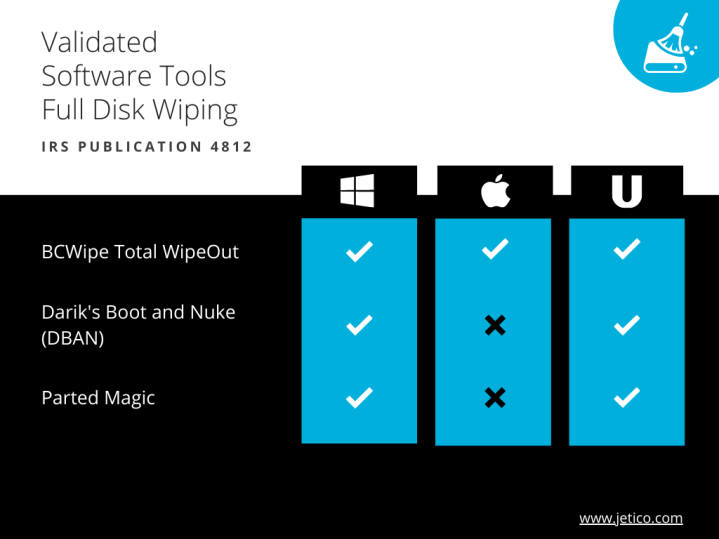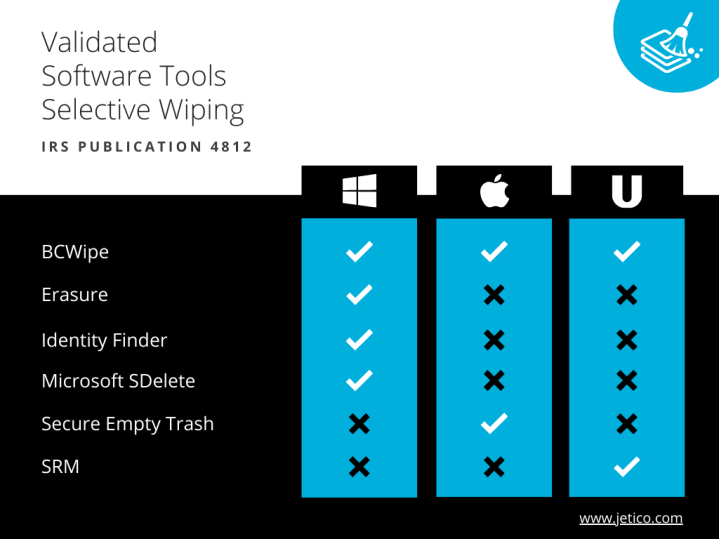



Organizations that have access to or manage Internal Revenue Service (IRS) data are required to comply with the wiping standards outlined in Publication 4812: Contractor Security & Privacy Controls.
In this blog, we summarize what the IRS says about full disk and selective wiping. Finally, we will share 3 tips on how to implement a successful IRS compliance strategy.

Page 82 of the publication explains that the most common way to clear data is to “perform a disk wipe using a software tool that overwrites all sectors of the disk with positive and negative (0 and 1) values.” The publication goes on to state: “IRS standards require 7 overwrites when the data contains FTI [Federal Tax Information], otherwise 3 passes are acceptable.”
According to Publication 4812, full-disk wipes must be applied to workstations and laptops. The following 3 software tools are the only solutions that the publication lists as being validated by the International Standards Organization (ISO):

Page 82 of the publication says that “partial data clearing can be appropriate for IRS data stored on file servers that also contain other customer information.” Organizations can use software tools to overwrite selected files and folders, therefore retaining the data of other customers. Like with full disk wiping, there are only a few solutions that Publication 4812 lists as being validated by the ISO:
By following these 3 steps, you can ensure that your organization is able to comply with IRS wiping standards:
1. Understand where your data resides
It's your responsibility to know where your data is, even if you outsource data storage to a cloud provider. Map your data flows and build a clear picture of where your information is located, as well as how it’s being accessed and shared. When the time comes, finding the information to erase will be much faster and easier.
2. Classify and get organized
The next step is to get (and stay) organized. Start by creating an inventory – classify data by importance and level of risk. It’s also a good idea to put someone formally in charge of data protection. This sends a message to your customers (and compliance officers) that you take the protection of their data seriously.
3. Equip the right tools
What kind of data do you need to erase? Answering this question will help you understand what type of software to use.
Like Publication 4812 says, the way to dispose of sensitive information is to overwrite it with a software tool that’s been validated by the International Standards Organization (ISO). BCWipe is the only solution to deliver both full disk and selective wiping, as well as being the only solution that can be used on all 3 operating systems. A trusted data wiping solution that securely erases drives and selected files beyond forensic recovery, BCWipe also follows all NIST requirements.
To get started with Jetico’s data wiping solutions, contact our Data Protection Specialists and request a free trial. To learn more about how to securely wiping your data, read our ultimate guide.
Related Articles
Data Sanitization 5 Common Myths
Hardware Decommissioning Process: A 5-Step Checklist
The Ultimate Guide to Deleting Files Permanently
CMMC 2.0 Levels, Controls & Framework for Media Sanitization Requirements
NIST SP 800-88 Guidelines for Media Sanitization Explained
IEEE 2883-2022 Standard for Sanitizing Storage
How to Securely Wipe Your Windows 11 Computer Clean
How to Wipe an NVMe Drive
How to Delete Files on SSD

Jetico Technical Support helps customers find answers...
- Access our knowledge base articles
- Watch our How-To videos
- Contact us for insights